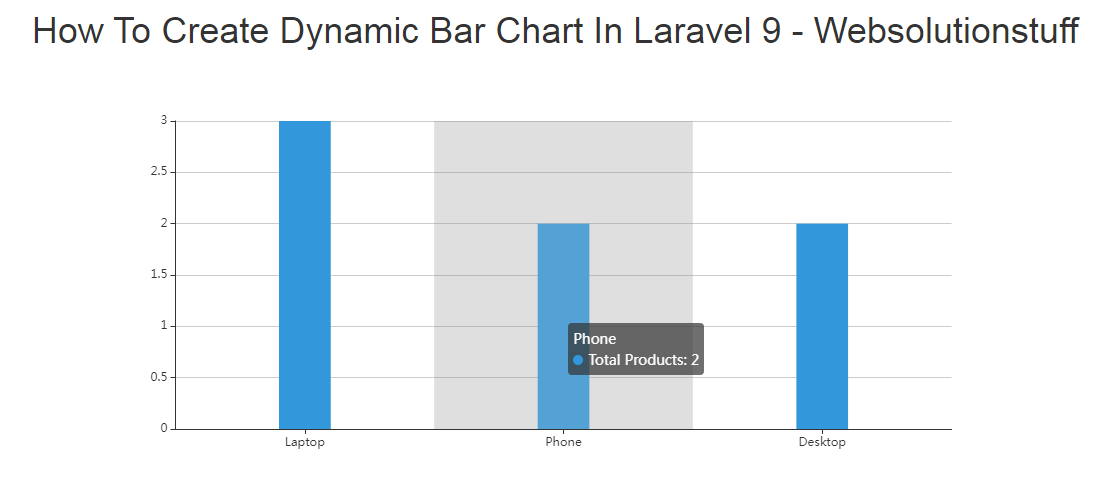In this article, we will see how to create a dynamic bar chart in laravel 9. Bar charts are used to represent data in graphics view. For the creation of a dynamic bar chart example, you need to create a route, controller, blade file, and database.
So, let's see dynamic bar chart in laravel 9, bar chart in laravel 9, laravel 9 bar chart js, dynamic charts in laravel 9, create dynamic bar chart in laravel 9, bar chart in php.
Step 1 : Install Laravel 9 For Dynamic Bar Chart
Step 2 : Create Migration Table
Step 3 : Add Route
Step 4 : Create Controller And Model
Step 5 : Add Code In Controller
Step 6 : Create Blade File For Dynamic Bar Chart
In this step, we will create the laravel 9 project using the below command.
composer create-project --prefer-dist laravel/laravel barchartAfter project setup, we need dynamic data for the bar chart example. So, we have to create migration for the "product" table using the below command.
php artisan make:migration create_products_table --create=productsAfter run this command you will find the PHP file on location "database/migrations/". And in this file add the below code.
<?php
use Illuminate\Database\Migrations\Migration;
use Illuminate\Database\Schema\Blueprint;
use Illuminate\Support\Facades\Schema;
class CreateProductTable extends Migration
{
/**
* Run the migrations.
*
* @return void
*/
public function up()
{
Schema::create('product', function (Blueprint $table) {
$table->id();
$table->string('name')->nullable();
$table->integer('price')->nullable();
$table->integer('year')->nullable();
$table->string('product_type')->nullable();
$table->timestamps();
});
}
/**
* Reverse the migrations.
*
* @return void
*/
public function down()
{
Schema::dropIfExists('product');
}
}After these changes we need to run this migration by the following command in our terminal:
php artisan migrateNow, add a route in the routes/web.php file.
<?php
use Illuminate\Support\Facades\Route;
use App\Http\Controllers\BarchartController;
/*
|--------------------------------------------------------------------------
| Web Routes
|--------------------------------------------------------------------------
|
| Here is where you can register web routes for your application. These
| routes are loaded by the RouteServiceProvider within a group which
| contains the "web" middleware group. Now create something great!
|
*/
Route::get('/', function () {
return view('welcome');
});
Route::get('bar-chart', [BarchartController::class,'barchart']);After adding the route, we need to create a new controller and model for the bar chart example. So, type the below command for creating a controller.
php artisan make:controller BarchartControllerphp artisan make:model ProductAdd below code in your app\Http\Controllers\EchartController.php file.
<?php
namespace App\Http\Controllers;
use Illuminate\Http\Request;
use App\Product;
class BarchartController extends Controller
{
public function barchart(Request $request)
{
$Laptop = Product::where('product_type','Laptop')->get();
$Phone = Product::where('product_type','Phone')->get();
$Desktop = Product::where('product_type','Desktop')->get();
$laptop_count = count($Laptop);
$phone_count = count($Phone);
$desktop_count = count($Desktop);
return view('barchart',compact('laptop_count','phone_count','desktop_count'));
}
}
Add below code in your Product Model in app\Models\Product.php file.
<?php
namespace App;
use Illuminate\Database\Eloquent\Model;
class Product extends Model
{
protected $guarded = [];
}
In this step, we are creating a barchart.blade.php file for view.
<!DOCTYPE html>
<html>
<head>
<meta charset="utf-8">
<meta http-equiv="X-UA-Compatible" content="IE=edge">
<title>How To Create Dynamic Bar Chart In Laravel 9 - Websolutionstuff</title>
<link rel="stylesheet" href="https://maxcdn.bootstrapcdn.com/bootstrap/3.3.7/css/bootstrap.min.css">
<link href="{{asset('assets/css/components.min.css')}}" rel="stylesheet" type="text/css">
<script src="https://cdnjs.cloudflare.com/ajax/libs/jquery/3.6.0/jquery.min.js" crossorigin="anonymous" referrerpolicy="no-referrer"></script>
<script src="https://cdnjs.cloudflare.com/ajax/libs/echarts/5.3.1/echarts.min.js" crossorigin="anonymous" referrerpolicy="no-referrer"></script>
</head>
<body>
<div class="col-md-12">
<h1 class="text-center">How To Create Dynamic Bar Chart In Laravel 9 - Websolutionstuff</h1>
<div class="col-md-8 col-md-offset-2">
<div class="col-xl-6">
<div class="card">
<div class="card-body">
<div class="chart-container">
<div class="chart has-fixed-height" id="bars_basic"></div>
</div>
</div>
</div>
</div>
</div>
</div>
</body>
</html>
<script type="text/javascript">
var bars_basic_element = document.getElementById('bars_basic');
if (bars_basic_element) {
var bars_basic = echarts.init(bars_basic_element);
bars_basic.setOption({
color: ['#3398DB'],
tooltip: {
trigger: 'axis',
axisPointer: {
type: 'shadow'
}
},
grid: {
left: '3%',
right: '4%',
bottom: '3%',
containLabel: true
},
xAxis: [
{
type: 'category',
data: ['Laptop', 'Phone','Desktop'],
axisTick: {
alignWithLabel: true
}
}
],
yAxis: [
{
type: 'value'
}
],
series: [
{
name: 'Total Products',
type: 'bar',
barWidth: '20%',
data: [
{{$laptop_count}},
{{$phone_count}},
{{$desktop_count}}
]
}
]
});
}
</script>Output :

You might also like :
- Read Also: Laravel 9 AJAX CRUD Example
- Read Also: How To Get Hourly Data In MySQL
- Read Also: Laravel 9 CRUD Operation Example
- Read Also: Laravel 9 Import Export CSV/EXCEL File Example





